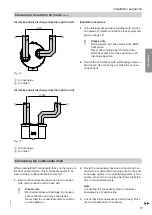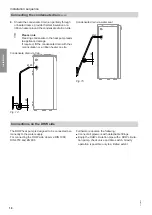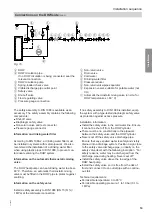
4
Danger
Unregulated escape of refrigerant in
enclosed spaces can lead to
breathing difficulties and suffoca-
tion.
■
Do not breathe dust/fumes/gas/
mist/vapours/spray (P260).
■
Ensure adequate ventilation in
enclosed spaces.
Perform the following measures before
beginning work on the refrigerant circuit:
■
Check the refrigerant circuit for leaks.
■
Ensure very good ventilation especially
in the floor area and sustain this for the
duration of the work.
■
Inform all persons in the vicinity of the
system about the type of work to be
carried out.
■
Secure the area surrounding the work
area.
Danger
Damage to the refrigerant circuit
can cause refrigerant to enter the
hydraulic system. This can cause
serious damage to health.
After completion of work on the
refrigerant circuit, professionally
vent the hydraulic system on the
primary and secondary sides.
Repair work
!
Please note
Repairing components that fulfil a
safety function can compromise the
safe operation of the system.
Replace faulty components only
with genuine Viessmann spare
parts.
Auxiliary components, spare and
wearing parts
!
Please note
Spare and wearing parts that have
not been tested together with the
system can compromise its func-
tion. Installing non-authorised com-
ponents and making non-approved
modifications or conversions can
compromise safety and may invalid-
ate our warranty.
For replacements, use only original
spare parts supplied or approved by
Viessmann.
Safety instructions for operating the system
What to do if water escapes from the
appliance
Danger
If water escapes from the appliance
there is a risk of electric shock.
Switch off the heating system at the
external isolator (e.g. fuse box,
domestic distribution board).
Danger
If water escapes from the appliance
there is a risk of scalding.
Never touch hot heating water.
Safety instructions
Safety instructions
(cont.)
6136003





































